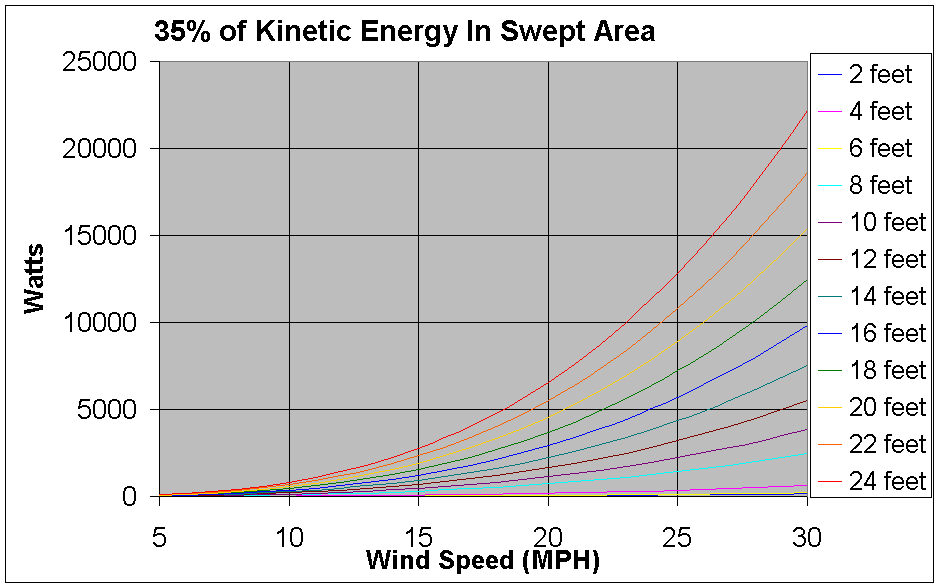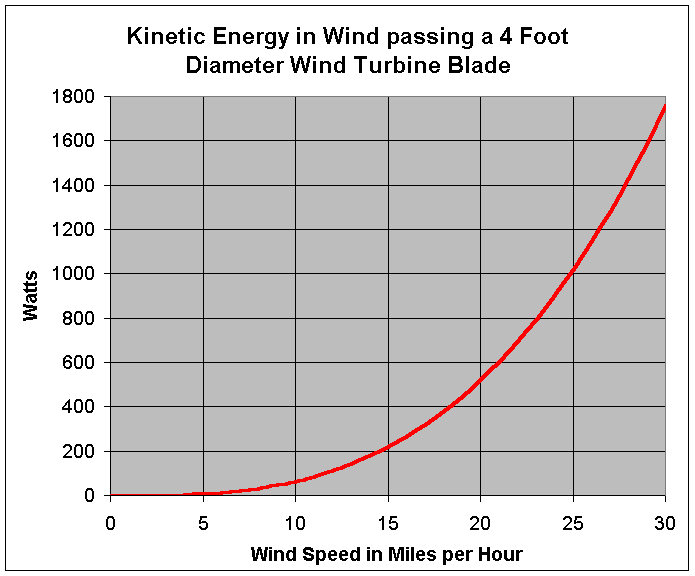I would certainly have a look at DanB's blade page which is accessable under the wind section off of the front page of the Otherpower site. He has some pretty good instructions on carving wooden blades. It doesn't seem to me that your PVC blades are performing properly.
The previous chart only showed the blade rpm at the tip speed ratio, it didn't show the power you could capture at that speed.

Note that on the legend, while the colors are correct, the bottom most curve is listed on the top of the legend, I meant to correct that to make it a bit less confusing, but I have not done so yet. The curves show the power at 35% which is possible within a narrow band of wind speeds for an efficient axial flux machine.

This is the curve showing the kinetic energy in the wind passing through a 4 foot diameter swept area. The bad news is that you will likely only achieve an efficiency of 25% or less with a tape drive mill.
While you can spin up a smaller blade set faster, the power into the shaft will be lower once you exceed the cut in speed because the available power in the wind passing through the blades is less in an amount proportionate to the swept area. For the 4 foot set, you are probably looking at about 65 Watts of total kinetic energy in a 10Mph breeze, of which you will probably only capture about an Amp or 12 to 13 watts. Now the swept area in a 4 foot diameter blade is (16/9) or 1.77 times greater than for a 3 foot diameter blade set.
If the blades are so small that they are greatly mismatched in speed and power to the alternator, they will not be able to push the speed up as the wind speed increases, they will tend towards stall, and the power out will be reduced further. Conversly if the blades are to large, the drag placed on them from the alternator will not be sufficient to keep them from running away to destruction in higher winds. Looking at the chart from the earlier post, with a 4 foot blade, you would be aiming for a cut in wind speed of about 8MPH and with a 5 foot at about 10MPH. You would probably get overall more power out with a larger prop, but it will be idle more unless you carve it for a faster TSR. My logic on this is that for battery charging you want to get power into the battery as much of the time as possible, for grid tie, you want to maximize the overall power produced. I would probably not go larger than 5 foot, or you may not reach cut in most of the time. Most places have an average wind speed of 11 MPH and a wind speed distribution that puts the wind below that speed much of the time. Higher TSR blades tend to be noisier, and since they are thinner with less solidity, they can be more problematic at startup for a given blade diameter. This is just my opinion, but in your case, I would likely stick to a 4 foot diameter, TSR7, since in periods of higher winds you will likely not have the battery capacity to store the power you make anyway.
Rich Hagen